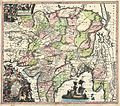ملف:1740 Seutter Map of India, Pakistan, Tibet and Afghanistan - Geographicus - IndiaMogolis-seutter-1740.jpg

حجم هذه المعاينة: 679 × 600 بكسل. الأبعاد الأخرى: 272 × 240 بكسل | 543 × 480 بكسل | 869 × 768 بكسل | 1٬159 × 1٬024 بكسل | 2٬318 × 2٬048 بكسل | 5٬000 × 4٬418 بكسل.
الملف الأصلي (5٬000 × 4٬418 بكسل حجم الملف: 8٫42 ميجابايت، نوع MIME: image/jpeg)
تاريخ الملف
اضغط على زمن/تاريخ لرؤية الملف كما بدا في هذا الزمن.
| زمن/تاريخ | صورة مصغرة | الأبعاد | مستخدم | تعليق | |
|---|---|---|---|---|---|
| حالي | 20:49، 22 مارس 2011 |  | 5٬000 × 4٬418 (8٫42 ميجابايت) | BotMultichillT | {{subst:User:Multichill/Geographicus |link=http://www.geographicus.com/P/AntiqueMap/IndiaMogolis-seutter-1740 |product_name=1740 Seutter Map of India, Pakistan, Tibet and Afghanistan |map_title=Imperii Magni Mogolis sive Indici Padschach, juxta recentiiss |
استخدام الملف
الصفحة التالية تستخدم هذا الملف:
الاستخدام العالمي للملف
الويكيات الأخرى التالية تستخدم هذا الملف:
- الاستخدام في beta.wikiversity.org
- الاستخدام في bn.wikipedia.org
- الاستخدام في ca.wikipedia.org
- الاستخدام في cs.wikipedia.org
- الاستخدام في el.wikipedia.org
- الاستخدام في en.wikipedia.org
- الاستخدام في eo.wikipedia.org
- الاستخدام في es.wikipedia.org
- الاستخدام في incubator.wikimedia.org
- الاستخدام في it.wikipedia.org
- الاستخدام في pnb.wikipedia.org
- الاستخدام في ru.wikipedia.org
- الاستخدام في te.wikipedia.org
- الاستخدام في ur.wikipedia.org
- الاستخدام في www.wikidata.org


